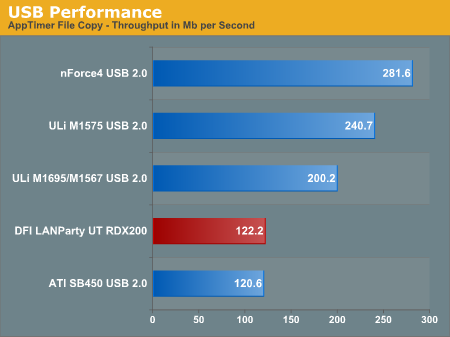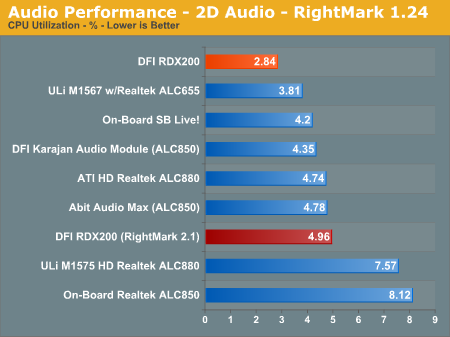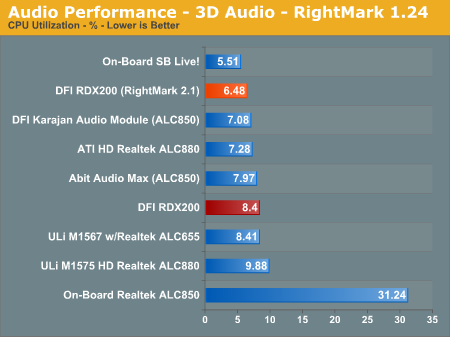DFI LANParty UT RDX200: ATI’s Crossfire AMD for the Bleeding Edge
by Wesley Fink on October 18, 2005 11:03 AM EST- Posted in
- Motherboards
Performance of Features
When you receive a board Friday afternoon that will go on sale Tuesday morning, there is sometimes just not enough time to complete all the tests that you initially planned. In the interest of bringing you the most significant test results on the DFI RDX200, we concentrated on two areas of interest, specifically USB Performance and CPU utilization of the Karajan audio module.
For additional information on the performance of other Storage, Ethernet, and Firewire, please go to other recent ATI Rx480/482 reviews at "ATI's Crossfire: Best Overclocker on the Market?" and "Sapphire PURE Innovation - ATI's Chipset for the AMD Enthusiast". The performance of the feature accessory chips present on the DFI RDX200 are tested in those reviews.
USB Performance
USB has been a problem area for the ATI SB450 chipset, so we decided to see if anything had changed. We ran our standard USB throughput test on the DFI using an external USB hard drive.
Our test method uses a RAM disk as our "server", since memory removed almost all overhead from the serving end. We also managed to turn off disk caching on the USB and Firewire side by setting up the drives for "quick disconnect" and our results were then consistent over many test runs.
We use just 1GB of fast 2-2-2 system memory set up as a 450MB RAM disk and 550MB of system memory. Our stock file is the SPECviewPerf install file, which is 432,533,504 bytes (412.4961MB). After copying this file to our RAM disk, we measured the time for writing from the RAM disk to our external USB 2.0 or Firewire 400 or Firewire 800 drive using a Windows timing program written for AnandTech by our own Jason Clark. The copy times in seconds were then converted into Megabits per second (Mb) to provide a convenient means of comparing throughput. Higher Rates, therefore, mean better performance.
There is an alternative in the ULi M1575 southbridge, which we recently tested. The ULi SB provides competitive USB performance and the SATA2 ports, which are missing from the ATI SB450 - and it is available today. We asked DFI why they chose the SB450 instead and they responded that the design work for the RDX200 was far along when the M1575 became an alternative. DFI also pointed out that M1575 and SB450 are not pin-compatible, thus making a last minute change in southbridge to be a very costly option. The SB600 should be pin-compatible with SB450, as M1575 is pin-compatible with M1573. When the SB600 is available, DFI will use the SB600 instead. They may also consider an SB change in their upcoming ATI dual x16 motherboard.
Audio Performance
For audio testing, we used Rightmark 3D Sound CPU utilization test, which is the same benchmark run in our earlier nForce4 SLI and Ultra roundups. This benchmark measures the overhead or CPU utilization required by a codec or hardware audio chip. We tested performance both with the earlier version 1.24 that we had used for past testing and the latest version 2.1. As you will see, 2.1 does yield different performance numbers.
It is very important to point out that the DFI LANParty UT RDX200 is the first Athlon 64 retail motherboard to deliver Azalia High Definition audio. Those who have been complaining about the poor AC'97 audio present on most AMD boards should be very pleased to find Azalia HD on the ATI chipset boards.
DFI claims that the Karajan module lowers noise using an on-board audio solution. We did some subjective listening tests with the DFI's version of Azalia HD through a Dolby amplifier and a 5.1 speaker setup. We really couldn't hear a huge improvement over our last listening tests of ATI Azalia HD. Perhaps that was because our last experience with Azalia HD on AMD was so good. HD really is in a completely different league from the other audio solutions that we have tested on Athlon 64. Noise was virtually non-existent, and imaging and depth were superb when listening to demanding CDs. The same CD sounded thin, noisy, and artificial through a more common ALC850 fed to the same Dolby amp and 5.1 speakers. This is not to say that the Azalia HD is at the same level as the very best audio cards, but it is a lot closer than you might think.
When you receive a board Friday afternoon that will go on sale Tuesday morning, there is sometimes just not enough time to complete all the tests that you initially planned. In the interest of bringing you the most significant test results on the DFI RDX200, we concentrated on two areas of interest, specifically USB Performance and CPU utilization of the Karajan audio module.
For additional information on the performance of other Storage, Ethernet, and Firewire, please go to other recent ATI Rx480/482 reviews at "ATI's Crossfire: Best Overclocker on the Market?" and "Sapphire PURE Innovation - ATI's Chipset for the AMD Enthusiast". The performance of the feature accessory chips present on the DFI RDX200 are tested in those reviews.
USB Performance
USB has been a problem area for the ATI SB450 chipset, so we decided to see if anything had changed. We ran our standard USB throughput test on the DFI using an external USB hard drive.
Our test method uses a RAM disk as our "server", since memory removed almost all overhead from the serving end. We also managed to turn off disk caching on the USB and Firewire side by setting up the drives for "quick disconnect" and our results were then consistent over many test runs.
We use just 1GB of fast 2-2-2 system memory set up as a 450MB RAM disk and 550MB of system memory. Our stock file is the SPECviewPerf install file, which is 432,533,504 bytes (412.4961MB). After copying this file to our RAM disk, we measured the time for writing from the RAM disk to our external USB 2.0 or Firewire 400 or Firewire 800 drive using a Windows timing program written for AnandTech by our own Jason Clark. The copy times in seconds were then converted into Megabits per second (Mb) to provide a convenient means of comparing throughput. Higher Rates, therefore, mean better performance.

There is an alternative in the ULi M1575 southbridge, which we recently tested. The ULi SB provides competitive USB performance and the SATA2 ports, which are missing from the ATI SB450 - and it is available today. We asked DFI why they chose the SB450 instead and they responded that the design work for the RDX200 was far along when the M1575 became an alternative. DFI also pointed out that M1575 and SB450 are not pin-compatible, thus making a last minute change in southbridge to be a very costly option. The SB600 should be pin-compatible with SB450, as M1575 is pin-compatible with M1573. When the SB600 is available, DFI will use the SB600 instead. They may also consider an SB change in their upcoming ATI dual x16 motherboard.
Audio Performance
For audio testing, we used Rightmark 3D Sound CPU utilization test, which is the same benchmark run in our earlier nForce4 SLI and Ultra roundups. This benchmark measures the overhead or CPU utilization required by a codec or hardware audio chip. We tested performance both with the earlier version 1.24 that we had used for past testing and the latest version 2.1. As you will see, 2.1 does yield different performance numbers.



It is very important to point out that the DFI LANParty UT RDX200 is the first Athlon 64 retail motherboard to deliver Azalia High Definition audio. Those who have been complaining about the poor AC'97 audio present on most AMD boards should be very pleased to find Azalia HD on the ATI chipset boards.
DFI claims that the Karajan module lowers noise using an on-board audio solution. We did some subjective listening tests with the DFI's version of Azalia HD through a Dolby amplifier and a 5.1 speaker setup. We really couldn't hear a huge improvement over our last listening tests of ATI Azalia HD. Perhaps that was because our last experience with Azalia HD on AMD was so good. HD really is in a completely different league from the other audio solutions that we have tested on Athlon 64. Noise was virtually non-existent, and imaging and depth were superb when listening to demanding CDs. The same CD sounded thin, noisy, and artificial through a more common ALC850 fed to the same Dolby amp and 5.1 speakers. This is not to say that the Azalia HD is at the same level as the very best audio cards, but it is a lot closer than you might think.










48 Comments
View All Comments
bigtoe36 - Tuesday, October 18, 2005 - link
having tested the RDX200 at the same time as Wesley I am able to confirm that i was able to run cas1.5. Now on the NF4 LP boards oskar enabled what seemed to be cas1.5, infact this option gave no performance increase over the cas2 option. On RDX200 he has though found a significant speed increase by using the 1.5 option.Running OCZ PC4800Plat's with drive srength at 9 and 1.5-2-2-5 timings a 100MB/s increase in available memory bandwidth was seen over setting 2-2-2-5. I was however forced to use 3.1Vdimm to achieve this at 200fsb 1:1. Another point is that BH5 and VX (UTT CH5) would not do cas1.5, it seems to be a samsung TCCX tweak only.
mongoosesRawesome - Tuesday, October 18, 2005 - link
thanks for the infoLeper Messiah - Tuesday, October 18, 2005 - link
Used to be buy an nVidia mobo and an ATi graphics card. Funny how things have changed...but 4DS at 1T is awesome if you aren't OCing your RAM, but 250-2-2-2-7 2T is going to be faster than 203 2-2-2-7-1T.Madellga - Tuesday, October 18, 2005 - link
Thanks for the good review Wesley. One thing I always missed on your reviews was what kind of BIOS settings you used.It took me a long time to get my DFI-NF4 up and running. You know better than anybody that tweaking is time consuming - specially with so many settings on the BIOS.
Make this an habit and keep posting the BIOS settings used on the reviews.
mongoosesRawesome - Tuesday, October 18, 2005 - link
Isn't that integrated into the A64 memory controller and don't the Nforce 4 DFI boards support those DDR speeds?
Wesley Fink - Tuesday, October 18, 2005 - link
The additional ratios are available in the AMD Athlon64 Rev. E Memory Cntroller and can be implemented on any Socket 939 motherboard. However, the BIOS writer has to implement these choices. AMD made them a part of their Reference Board and they will likely find their way to many retail boards. DFI implemented them on the RDX200, but you rarely if ever see these finer ratios actually implemented on nForce4 boards.jr9k - Tuesday, October 18, 2005 - link
2000 points.
Impressive...
until you do some math. 4 dimms at 1T are 2.3% faster than 4 dimms at 2T.
Don't get me wrong, the achievement of running four dimms at 1T is impressive, but the results are not (as we already knew). It's the way of showing things.
Anyway, it is good to see some competition from ATI.
Nice review and nice board
mongoosesRawesome - Tuesday, October 18, 2005 - link
Yea, I agree. A lot of times a big deal is made over only a few percentage points. I would have rather seen FPS in some games. I truly doubt we'd even see 2% in some cases.Spacecomber - Tuesday, October 18, 2005 - link
I had the same sort of reaction to the signifigance of the 1T vs 2T scores. I translated the Aquamark score back into FPS got this.2 DIMM 1T 91fps
4 DIMM 2T 90fps
4 DIMM 1T 92fps
While this capability certainly says good things about DFI's engineering team, I'm not sure that I'd spend a $100 premium on a motherboard just to get this feature.
Overall, this is a board with very good potential, but I wouldn't want to rush out and buy this first release. It sounds like the revision with a different south bridge will be worth waiting for. Hopefully, the price will be mroe in line with the comparable nforce4 boards by then, too.
ksherman - Tuesday, October 18, 2005 - link
I am particularly impressed with the ability to use 4DS DIMMs @ 1T. That is a really nice little feature! Too bad you have to stay near stock speeds... is it possible to do some overclocking, but use divides to keep the memory at 406? or is overclocking the memory the better thing to improve system performance?